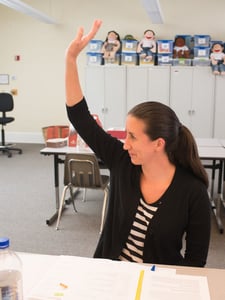
We talk parallel process all the time in the hallways (and virtual hallways) at Teachstone. The topic is embedded in our CLASS Feedback training, and it’s all the rage in our Fundamentals of Coaching e-book. So we know that parallel process is important in coaching relationships, but what about in a training like CLASS Observation?
Wait—Back Up. What is this “parallel process” of which you speak?
Ah, yes. Parallel process means engaging in the same CLASS-based interaction strategies we want teachers to use in classrooms with children, only this time, between adults. Instead of teacher-child interactions, parallel process is about adult-adult interactions that align with the CLASS tools.
Hold up. I only have two days and a lot to cover with my Observation participants. How CLASSy can I get?
We say, pretty CLASSy! Sure, we train participants to become reliable observers with only a couple of days to get to know one another. And, we definitely have some specific and scripted skills that we have to teach, such as the coding process and notetaking. In spite of those limitations, here are some examples of how to use the parallel process, per CLASS Domain.
Emotional Support
Think Positive Climate, Teacher Sensitivity, and Regard for Student Perspectives. I can infuse these dimensions by smiling, laughing, and clearly enjoying being with my participants. If I use their names and listen carefully when my participants contribute to a discussion, I’m engaging in all kinds of Positive Climate interactions. When I notice someone is struggling with an indicator, and I take a moment to check in with her, I'm aware and responsive; the hallmarks of Teacher Sensitivity. If I notice that my participants are freely participating, and contributing to the conversation, they are comfortable. To show Regard for [Participant] Perspectives, I can offer them choices, such as inviting partner or individual work on activities. And I can encourage participant expression throughout the training.
Classroom Organization
All right, here think Behavior Management, Productivity, and Instructional Learning Formats. Now, we are working with adults, but it is still helpful to set up a couple of “house rules.” I usually have to create some cell phone rules, for example. When I notice that a couple of participants are talking and bothering others who are still coding, I can respectfully redirect. Productivity is all about being prepared with my materials, giving clear instructions for activities, and filling downtime with things they could be doing (such as reading descriptive paragraphs, organizing their manual, highlighting essential sentences). And Instructional Learning Formats is all about engaging my participants by asking questions and using all the modalities available including the PPT, score sheets, manual, and activities. My participants are (hopefully) engaged in the training as a result!
Instructional Support
Finally, think Concept Development, Quality of Feedback, and Language Modeling. By replacing closed-ended questions such as “What indicators are in Positive Climate” with open-ended questions, such as “How do you know when an interaction fits in Positive Climate?” I can move away from rote instruction. When I use relevant, real-world examples during indicator introductions and compare and contrast those with a previous indicator, I’m adding Concept Development into the training. When I query a participant's response by saying, “Yes, there is evidence of positive communication, how do you know?” I’m starting a feedback loop. If rather than just giving a participant the answer, I support them in figuring it out first using hints and assistance, I’m scaffolding. And as I listen carefully and contingently respond to participants, I’m engaging in Language Modeling.
Using the parallel process in your observation training is a game changer! Participants who experience a comfortable emotional climate that is organized, engaging, and intellectually challenging take away more than just newfound CLASS knowledge. They actually experience CLASS!
How do you use the parallel process during CLASS Observation Training?

